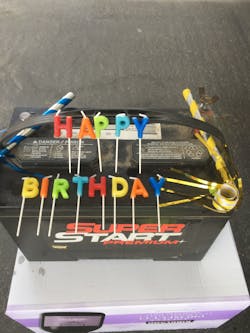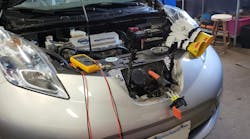Battery and Charging System Issues
Vehicles affected: All
Tools Used:
- Vehicle Specific Information
- Battery/Charging System Test Equipment
- Battery Charger
- DMM
- Scan Tool
- Tools for Testing Parasitic Draw
- Battery Reset Tool
The technology in today’s vehicles is in a constant state of change, and even systems that seem somewhat stable like battery, starting and charging systems are going through a transitional phase. With these changes, the tools required to test and repair them also require transformation.
Let’s first take a look at some of the technological changes to the battery. The common battery for decades has been the Flooded Lead Acid Battery. These batteries were designed to provide enough power to the starter and ignition system to start the vehicle. Once the vehicle starts the alternator takes over, supplying enough electrical power to operate the electrical system. These batteries also act as a “cushion” to even out voltage spikes from the charging system and on-off electrical loads.
Additionally, they supply stand-by power for keep-alive memory functions for electronic systems, such as computer memory and clock functions. The advantages of this type of battery are that they are relatively inexpensive when compared to newer designs. They are also reliable, and are suitable for most climates. The disadvantages of these batteries are that they will not last as long as most newer designs, and they are not able to provide enough power in high demand accessory load situations without substantially increasing their size and weight.
High electrical demands of newer vehicles, combined with the desire for lighter weight components and the need to place batteries in passenger or luggage compartments brought about significant changes in battery technology. Valve Regulated Lead Acid (VRLA) batteries, which are more commonly known as Gel Cell (GEL) or Absorbed Glass Mat (AGM) batteries are designed to provide more stand-by and cranking power than a traditional lead acid battery. Their design allows the battery to release more of its charge at once, so a larger storage capacity can be put into the same size battery, while its weight can be reduced. Because their design also allows them to basically recirculate gasses produced within the battery, they can be placed inside the vehicle. The disadvantages of this battery design are primarily the cost, and that they do not function as well in more extreme climates, whether hot or cold.
One of the newest battery designs is designated an Enhanced Flooded Battery (EFP). These were introduced to handle the demands of start/stop technology. These systems require the battery to sustain numerous draw-downs of voltage to lower than normal levels, then recharge them quickly.
Along with updated battery designs, vehicle manufacturers are still trying to reduce engine load to improve fuel economy. One way to accomplish this is to improve the charging system to reduce engine load while maintaining system voltage. This tactic makes the alternator more efficient and allows the charging system output to be matched with the specific needs of the battery. A traditional lead acid battery needs a different strategy to maintain the correct voltage and promote a long life than what an AGM battery requires. Vehicle manufacturers have accomplished charging system efficiency by producing smaller, more powerful alternators and regulating their output via the vehicle’s onboard computer system.
In order for the computer to control the output of the alternator, many manufacturers have added current and/or battery temperature sensing technology into the system. By design, AGM and Gel Cell batteries require the amperage of the charge be matched to the temperature of the battery. As the battery is charged, the temperature of the battery will increase, and the charge rate needs to be decreased in order to avoid damaging the battery. This is extremely important to remember while charging batteries in the shop. Modern charging systems utilize algorithms calculating electrical load, temperature and even the age of the battery to determine alternator output.
Step 1 – Obtain vehicle-specific information
Vehicle-specific information is required in order to do any of the following:
· Charge the battery
· Test the charging system
· Remove and install the battery
· Determine acceptable parasitic drain
· Restore battery communication to all computer modules
· Reset battery life monitor
· Relearn adaptive memories
Obtaining vehicle specific information is critical at the beginning of the testing process to ensure all of the tests performed are valid. Many vehicles have a specific process to charge the battery to make sure sensitive electronics are not damaged in the process.
You should obtain any relevant TSB’s and the specifications for the correct battery. I am sure you have seen a vehicle come into the shop where the customer chose to install a smaller battery to save money. However, neither the vehicle, nor the charging system can operate correctly if the battery does not have enough capacity. You will also need the minimum and maximum voltages allowed by the charging system, the amperage output of the alternator and the test procedure for testing the charging system.
Not all vehicles will require resetting the battery life monitor, but the point is that there is no longer a one-size-fits-all type of test or repair of a vehicle’s battery or charging system.
Step 2 – Test the battery -
Once you have acquired the specifications, the first thing you should do is test the base voltage of the battery and perform a visual inspection of the battery connections. Even the smallest amount of corrosion at a battery terminal will affect the system’s ability to function properly.
There was a time when you would connect a battery charger or tester to a vehicle and just crank up the charge rate or the load to test it, but current battery designs require new battery test equipment, test procedures and battery chargers. Even some of the newer versions of traditional lead acid batteries will require different testing and charging equipment due to improvements in their design.
Battery Test and Charging Equipment –
In the past, batteries were replaced when they failed and could not be recharged, or when they had a “Birthday,” meaning the battery was nearing its anniversary of the build date on the battery case. “Birthday” batteries were replaced when shops determined the average life of a battery in their climate and the battery installed on the vehicle was nearing that date, whether it was three, four or five years from its build date.
Most of the newest battery test equipment uses algorithms to calculate whether the battery is “good” or “bad.” In order to do so, the user will need to input information specific to the battery, such as Cold Cranking Amps (CCA) and the type, whether it is a lead acid, Gel, AGM or EFB battery. These inputs are critical for the tester to calculate the condition of the battery.
In some cases, a test cannot be performed unless the battery is charged to a specific voltage range. If so, you will need to connect a charger compatible with the specific battery and condition the battery to the proper voltage and temperature in order to test it.
Many battery test equipment manufacturers have developed testers that can test the battery without a complete charge. This means technicians can quickly decide whether to "charge and test again" or replace the battery, improving both customer satisfaction and shop efficiency.
Along with the equipment necessary to test the various types of batteries, improved battery charger technology is essential to be able to service each type of battery. New chargers have the ability to charge different types of batteries in the best way to ensure long life and reduce the possibility of over- or under-charging.
When purchasing a battery charger, take into consideration what types of batteries the charger will work with. If you are going to purchase new equipment, you may as well obtain the best tool that will be able to perform the most functions. Many chargers, like the Associated Equipment ESS6008MSK, the OTC 3176 and the Midtronics MCC-070, to name a few, have the ability to not only work with each type of battery, but can also provide the stable power necessary when reprogramming computer modules.
Replacing the Battery –
Even though in most cases, replacing a battery seems relatively straightforward, it is essential to use vehicle-specific information to do the job. For example, if you are replacing the 12V battery in a Hybrid Electric Vehicle (HEV), you will need to follow the process exactly to eliminate the possibility of damage to the vehicle's electrical system and potential safety hazards.
One thing you should avoid when replacing a HEV 12V battery is using a memory-saving tool. Using this type of tool may allow the capacitors in the system to remain charged and cause the high voltage circuit to continue to be energized.
Check for Parasitic Draw –
It is a good idea to test to see if there is any parasitic draw in the system that could cause the battery to drain over a short period of time.
Testing for a drain can easily be accomplished by using a DMM or specialty tools like the Cal-Van Amp Hound or Electronic Specialties Fuse Buddy connected in series from the battery cable to the battery. The amp reading -- with all accessories off -- should be within the vehicle specifications.
Restore Vehicle Communications –
Many vehicles will have specific procedures to restore communications and relearn adaptive strategies in their computer-controlled systems. These may include anything from turning different components on or off in a specific order, a test drive under controlled conditions or bidirectional control with a scan tool. Obtain the specific procedure from your vehicle information data base.
Reset Battery Life Monitor –
Some vehicles utilize the computer to calculate the life of the battery based on age, temperature, power loss and resistance, and will adapt the alternator output to the needs to maintain battery condition. If the battery is replaced, the monitor will need to be reset. The most common way to do this is with your scan tool, but a much quicker way is to use a tool such as the OTC 3112, or the Can-Do Batt+, which are designed to do this quickly without needing to navigate through your scan tool.
Since charging systems and the processes to test them have made significant advances in the past few years, we will discuss those changes, test procedures and the tools required to test them in more depth in an upcoming article.
In the meantime, if your battery test or charging equipment is more than a few years old, it’s likely time to upgrade. Dated battery testing and charging equipment is nearly obsolete when it comes to working on some of the newest vehicle technology.


